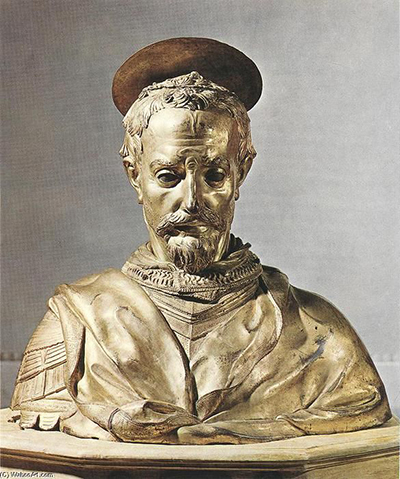Donatello produced a sculpture of Saint Rossore between 1422 and 1427 in the form of a bust showing the head and shoulders of the man
This sculpture represents a Christian martyr who died in the 3rd century AD. His skull had been obtained by monks who commissioned the work to house it as a holy relic in their church. Their church is translated as 'Church of All Saints', and it housed a number of important relics. The first impression of the sculpture appears be of piety; a pious man with his head bowed.
Interpreting St Rossore
Rossore was a Roman soldier who converted to Christianity. He was beheaded in Sardinia because of his beliefs and became posthumously a saint. Donatello's interpretation of this man is sculpted in the style of ancient Roman busts. It is a lifelike figure with the only movement being a slight bow to the head and the eyes looking down.
Why did Donatello choose this interpretation of the man? Donatello's decisions regarding his interpretation not only dictate the physical stance of the figure but also the materials used and the techniques to achieve the effect. The main impression of the work is one of piety.
St Rossore appears to be in a submissive pose by bowing his head. Bowing with his head, could be interpreted as bowing to his chosen religion and god in prayer and also in acquiescence of his fate. The figure mainly displays piety. Most people would see this sculpture as a pious man praying to his god. Donatello wanted to give the saint a Roman-style sculpture to house his holy relic, and probably to show St Rossore was a Roman who became a Christian.
The Materials and Techniques Chosen for this Sculpture
Donatello's workmanship of this piece is very intricate and detailed from the hair on his subject's head and beard to every line on the armour on one shoulder. He chose to use bronze to create this reliquary bust; metal to accentuate the impression of the soldier that St Rossore was, and to emphasise strength. He used bronze to indicate a soldier and not a nobleman.
There is no ornate colouring or designs within the main clothing, only the armour on the right-hand shoulder has intricate designs to highlight the armour worn by a soldier. Donatello attempted to describe his subject not only in the way the figure is positioned but by using materials that give an impression of the man.
Donatello wanted this man to have recognition as a soldier. This had an overall effect on the whole bust. This pious man was not a weak man and he had strength, like the bronze metal used to depict him.
Why this Sculpture is Different
This work by Donatello is set apart from other works he had produced, as there is a definite restriction of movement with this sculpture. Whether Donatello felt that St Rossore was a prisoner or that he was very restricted in his life and ostracised for his religion by his peers, or whether this effect of stillness accentuates the piety in the sculpture is not absolutely sure. Both effects appear in this reliquary bust of St Rossore.
St Rossore would not have been able to practise Christianity with any freedom and he may have been a prisoner for some time before his demise. The effect of this still figure is very pious and fitting for where the bust would be placed by the monks.
Did the Reason for the Sculpture Affect its Creation?
The monks wanted the holy relic in their church and Donatello would have made this a religious sculpture for the church. This does affect the position of the figure and the overall impression of the sculpture.
The figure appears pious and an obedient servant from the bowing of the head, and he appears to be thinking deeply and maybe praying, with his eyes looking downward. The reasoning behind this sculpture takes in the soldier St Rossore was, and the converted Christian he became.
He stayed true to his beliefs and was martyred for these beliefs. This soldier was a strong man physically and mentally. The reason for the sculpture was to house St Rossore's holy relic, and this bust displays the man very well.
Where the Sculpture is Now
This bust is now displayed in the National Museum in Pisa. The sculpture arrived in Pisa in 1591 and still remains there. Modern day art lovers and tourists can visit the museum to see this sculpture amongst many others. So many centuries have passed since this sculpture was created and it is still a masterpiece of religious art.




